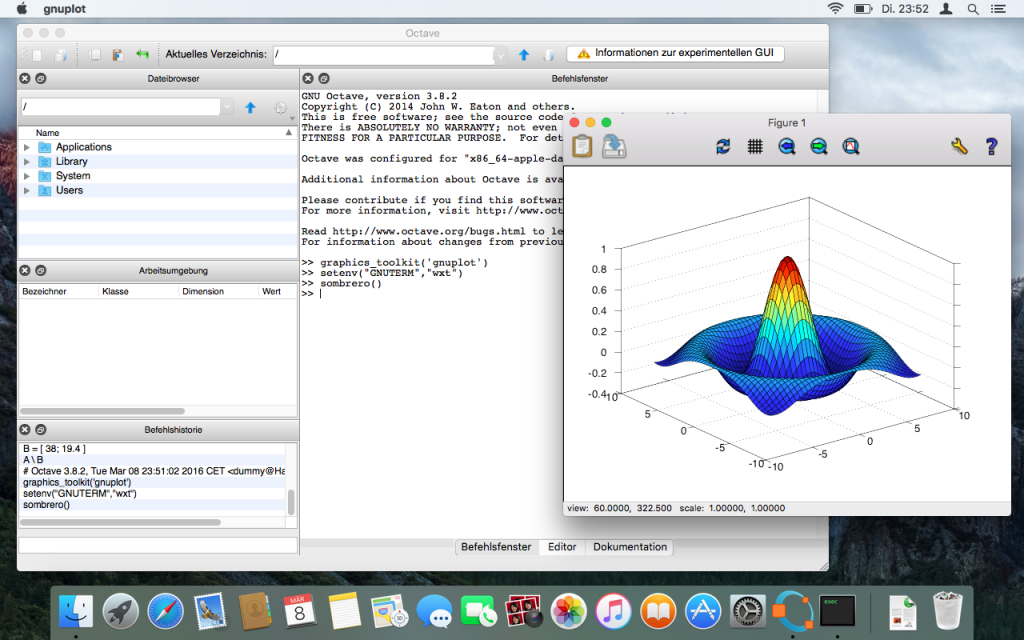Octave For Mac
Tech Epoka - If you are looking for MATLAB alternative then Octave is best alter.ternative because it's free. Here are 3 easy steps to install Octave on Mac. Easiest option would be using the precompilled.app I've tried the precompiled.app, but had issues with certain functions (like sound), whereas the macports version always worked. I usually install it using macports:. Sudo port install octave.
Download and install Octave
Samsung smart switch for mac. There are a number of Open Source alternatives to the program MatLab, one of the most known alternatives is GNU Octave. When using Octave you use a command line to enter commands. Octave can be downloaded and installed from GNU Octave.
Install on Mac
If using Mac:
Install Homebrew.
Install XCode from App Store.
Open and run the XCode app to agree to the License Agreement.
Install XQuartz.
Import science packages, open the terminal and enter:
Install Octave (this takes time):
Update:
At the end of the process a summary is shown displaying the path to Octave. If following is shown:
then the path to Octave is /usr/local/Cellar/octave/3.8.1/bin/Octave Open AppleScript Editor and make a New Document. Write following:
where /path/to/octave is the path. Save the script as Octave.app, select Application when saving.
For more information see Octave for MacOS X.
As a calculator
The easiest way to get started, is to use Octave as a calculator.
The arithmetic operators are:
There are predefined constants in Octave, some of them are listed below:
| constant | explanation |
|---|---|
pi , e , i | Make a wild guess! |
Inf (infinity) | Operations yielding numbers larger than the maximum floating point will give this answer. |
NaN (not a number) | Operations that can not be defined in any reasonably way will give this answer |
There are also a number of predefined mathematical functions in Octave, some of them are listed below:
| function | explanation |
|---|---|
sin, cos, tan | Trigonometric functions using radians |
asin, acos, atan | Inverse trigonometric functions |
exp, log, log10 | Exponential function, natural logarithm, logarithm to the base 10 |
sqrt | Square root |
abs | Absolute value |
round, floor, ceil | Round to nearest integer, round down, round up |
rem | Remainder when doing integer division |
Showing more decimals
You can show more decimals by typing format long. Go back to showing few decimals by typing format short.
Exercise 1
Calculate following expressions
- (sqrt[5]{200})
- (dfrac{3cdot 10^{-3}}{0.001+sqrt{0.2}})
- (dfrac{2^{3+sin{0.3}}+5}{10})
You should get these answers
ans = 2.8854ans = 0.0066932ans = 1.4819

You can see old commands by using up/down arrow keys.
Exercise 2
Guess the output of following commands, then check the answers given by Octave
1/0 0/0 tan(pi/2)inf+inf inf-inf inf/inf inf*infnan+2 nan+nan
Exit Octave
Exit Octave by writing exit or quit.
For most orders this will be the 'Ultra Saver' option. Special order items are non-refundable. 'Free Shipping' ExplainedExplainedFry's has made it even easier to take advantage of the Free Shipping promotion.Orders $35 or more ship free on qualifying items.  Free shipping will be noted on the product page and in your Cart,Free shipping only applies when selecting the lowest cost shipping method available. Free shipping is only available to addresses in the contiguous United States.Major Appliances and some PromoCode items are excluded from this offer.
Free shipping will be noted on the product page and in your Cart,Free shipping only applies when selecting the lowest cost shipping method available. Free shipping is only available to addresses in the contiguous United States.Major Appliances and some PromoCode items are excluded from this offer.
Numerical variables
When evaluating the value of an expression, the result is stored in a variable called ans (answer). You can also introduce variables of your own.
By writing who you can see all variables. If you write a semi colon at the end of the line, the output is not shown.
Naming variables

Various programs have different rules for naming entities. Although some modern programs allow for all kind of characters in names, you may run into trouble if you use characters like '-' or blank. If you want to stay on the safe side, never having to bother about naming-rules for specific programs, follow these old-school rules:
- The first character must be an english letter :
a-z,A-Z
Some programs can handle letters like å, Æ, Ç, ü; others cannot. Use english names when programming! - The name can include numbers :
0-9 - The name can include underscore :
_
These rules apply to Octave and a number of other programs.
Assignments
When writing a=5 at the command prompt, the equal-sign should not be thought of as a logical equality; a is not equal to 5, it is assigned the value 5. Having that in mind, one can write assignments like this
The statement above would be false if it was a logical statement, it is however not a logical statement but an assignment. The right-hand-side of the statement is calculated first, the result is then assigned to the variable on the left-hand-side.
Hiding the output and repeating previous commands
You can write several commands on one line by using comma, or semi colon. By using up-arrow, you can repeat the previous command, and alter it.
You can calculate a geometric series by using up-arrow several times.
Exercise 3
Calculate the series:
[sum_{i=1}^{20} left(frac{1}{i} right)^2 ](The answer is 1.5962)
Exercises on Sequences
A sequence is a function with the domain being the natural numbers. A sequence can be written like this (a_0,a_1,a_2,..) or like this
[left( a_n right)_{n=0}^{infty} ]Recurrence equations
A geometric progression can be defined in different ways. Consider the infinite geometric progression (3, 3cdot 2, 3cdot 2^2,..).
You can describe the geometric progression in two ways.
A recurrence equation:
[ left{ begin{align} a_0 &=3 a_{n+1} &=2cdot a_n, ngeq0 end{align} right. ]An explicit formula:
[a_n=3cdot 2^n, nin mathbb{n}]Exercise 4
Use Octave to find the limit as (nrightarrowinfty) of following sequences. Type format long to show more decimals. Try different initial values (c), do you get different limits?
- [ left{ begin{align} a_0 &=c a_{n+1} &=1+frac{1}{a_n}, ngeq0 end{align} right. ]
- [ left{ begin{align} a_0 &=c a_{n+1} &=sqrt{1+a_n}, ngeq0 end{align} right. ]
Try to explain your answers. If you fail, do the exercises on Calculus - Fixpoints.
| The Octave.app maintainers have released a statement regarding Richard Stallman. |
Octave.app is a project to bundle and distribute GNU Octave as a native Mac GUI application. This makes it easy to install and use GNU Octave on Mac.
We are not an official GNU project, or part of GNU Octave. We are a rag-tag band of misfits who’ve written a tool to download and build GNU Octave and its dependencies and bundle them as a Mac app.
Our goal is to make ready-to-use Octave.app installers available to the public.
Download
All Octave.app releases are available on the Downloads page.
When running Octave.app for the first time, instead of just double-clicking it, you will need to right-click on it and choose “Open”, so you get a dialog asking you if you really want to run it, since it’s from an unidentified developer. This is because the app is not signed. This is something we’re working on.
If you’re feeling adventurous, beta and pre-release versions can be found on the Developer Downloads page.
Requirements
- macOS, version 10.11 El Capitan or newer
- OpenJDK 11, if you want to use Java
- The exact version of the JDK required varies with the version of Octave.app; see the Downloads page for exact versions.
- MacTeX, if you want the help command to work properly for Octave Forge packages.
License
Most of Octave.app’s code is GPL, with the exception of its Homebrew formula files, which are BSD 2-Clause License.
GNU Octave itself is GPL. Its dependencies are available under various FLOSS licenses.
Alternate Installations
Installing with Homebrew Cask
To install Octave.app using Homebrew Cask:
Installing directly with Homebrew
NOTE: This is not the normal way to install Octave.app! Unless you have a particular reason for doing this, please just download and install the regular Octave.app distribution.
Octave For Mac Dmg
If you want to build and install our Qt-enabled Octave build via Homebrew instead of using the Octave.app distribution, you can do this by setting up Homebrew as normal, and doing the following:
Octave For Mac Os Yosemite
If you have a previous octave build from the regular Homebrew or dpo/openblas formulae, you need to unlink it first with brew unlink octave.
People and Support
Sebastian Schoeps is the original author and maintainer.
Octave For Macbook Pro
Andrew Janke is a maintainer.
For help with Octave.app, please head to the octave-app GitHub repo and see its issue tracker. Andrew also sometimes hangs out on the #octave channel on freenode IRC.
Acknowledgements
Octave For Mac
Octave.app is powered by Homebrew.